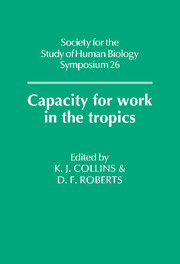Book contents
- Frontmatter
- Contents
- Preface
- Measurement of Working Capacity in Populations
- Functional Consequences of Malnutrition
- Malnutrition, work output and energy needs
- The role of working women in a rural environment when nutrition is marginally adequate: problems of assessment
- Defining anaemia and its effect on physical work capacity at high altitudes in the Bolivian Andes
- Marginal malnutrition in childhood: implications for adult work capacity and productivity
- Marginal energy malnutrition: some speculations on primary energy sparing mechanisms
- Growth, Stature and Muscular Efficiency
- Ethnic and Socio-Cultural Differences in Working Capacity
- Energy Expenditure and Endemic Disease
- Research Models in Tropical Ecosystems
- Index
Marginal energy malnutrition: some speculations on primary energy sparing mechanisms
Published online by Cambridge University Press: 15 March 2010
- Frontmatter
- Contents
- Preface
- Measurement of Working Capacity in Populations
- Functional Consequences of Malnutrition
- Malnutrition, work output and energy needs
- The role of working women in a rural environment when nutrition is marginally adequate: problems of assessment
- Defining anaemia and its effect on physical work capacity at high altitudes in the Bolivian Andes
- Marginal malnutrition in childhood: implications for adult work capacity and productivity
- Marginal energy malnutrition: some speculations on primary energy sparing mechanisms
- Growth, Stature and Muscular Efficiency
- Ethnic and Socio-Cultural Differences in Working Capacity
- Energy Expenditure and Endemic Disease
- Research Models in Tropical Ecosystems
- Index
Summary
INTRODUCTION
Energy nutritional status is a dynamic condition that might be described as the extent to which improvements can be made in terms of functions and capacities (such as work capacity and performance, reproductive competence, disease response, social and behavioral functions, growth performance, etc.) by changes in energy balance, its components, or the rate of energy flux (Ferro-Luzzi & Norgan, 1984a).
This definition stresses the need to induce a perturbation to evaluate energy nutritional status. Static measurements such as the size of body energy stores or the level of energy intake, output or balance, are unable to capture the dynamic nature of energy status, introduce an element of circular reasoning and can lead to very misleading results. In fact, except for relatively short periods of acute shortage of food, as in famines, droughts, and other man-made or godsent adversities, people do basically subsist in a state of long-term energy equilibrium. This equilibrium, however, may be variously achieved. Figure 1 encompasses the known or postulated mechanisms called upon to save, or waste, energy under conditions of energy disbalance. Energy equilibrium type 1 is intrinsically different in quality, nature, impact and consequences from equilibrium conditions types 2 and 3.
The latter condition, namely the type of equilibrium achieved when energy intake is smaller than output, is of enormous importance as it is assumed or suspected that it represents the condition shared by a large proportion of humanity living in less-developed countries (LDC).
- Type
- Chapter
- Information
- Capacity for Work in the Tropics , pp. 141 - 164Publisher: Cambridge University PressPrint publication year: 1988
- 5
- Cited by



